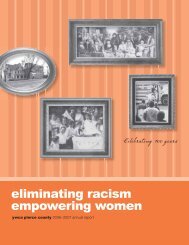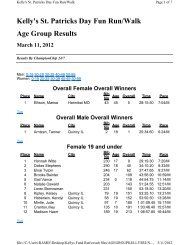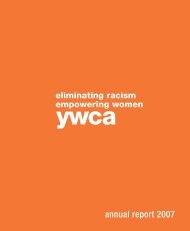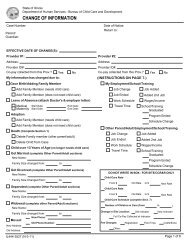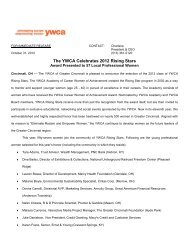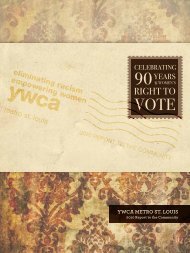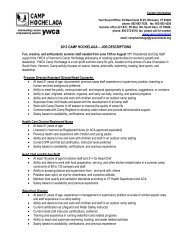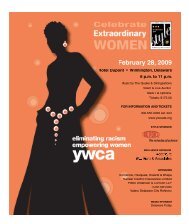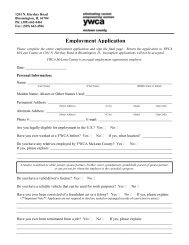Structural Racism (.pdf) - Intergroup Resources
Structural Racism (.pdf) - Intergroup Resources
Structural Racism (.pdf) - Intergroup Resources
Create successful ePaper yourself
Turn your PDF publications into a flip-book with our unique Google optimized e-Paper software.
Chronic Disparity: Strong and Pervasive Evidence of Racial InequalitiesPOVERTY OUTCOMESDefinitions and Descriptions of <strong>Racism</strong>• WHITE SUPREMACY: White supremacy is an historically based, institutionallyperpetuated system of exploitation and oppression of continents, nations and peoplesof color by white peoples and nations of the European continent; for the purpose ofmaintaining and defending a system of wealth, power and privilege.• WHITE (as in •white people”): The term white, referring to people, was created byVirginia slave owners and colonial rulers in the 17th century. It replaced terms likeChristian and “Englishman” (sic) to distinguish European colonists from Africans andindigenous peoples. European colonial powers established white as a legal conceptafter Bacon’s Rebellion in 1676 during which indentured servants of European andAfrican descent had united against the colonial elite. The legal distinction of whiteseparated the servant class on the basis of skin color and continental origin. “Thecreation of ‘white’ meant giving privileges to some, while denying them to otherswith the justification of biological and social inferiority. (Margo Adair & SharonPowell, The Subjective Side of Politics. SF: 1988. p.17.)• WHITE PRIVILEGE: A privilege is a right, favor, advantage, immunity, speciallygranted to one individual or group, and withheld from another. (Websters. Italicsmine.)White privilege is an historically based, institutionally perpetuated system of: (1)Preferential prejudice for and treatment of white people based solely on their skincolor and/or ancestral origin from Europe; and (2) Exemption from racial and/ornational oppression based on skin color and/or ancestral origin from Africa, Asia, theAmericas and the Arab world.U.S. institutions and culture (economic, legal, military, political, educational,entertainment, familial and religious) privilege peoples from Europe over peoplesfrom the Americas, Africa, Asia and the Arab world. In a white supremacy system,white privilege and racial oppression are two sides of the same coin. “White peopleswere exempt from slavery, land grab and genocide, the first forms of white privilege(in the future US).” (Virginia Harris and Trinity Ordoña, “Developing Unity amongWomen of Color: Crossing the Barriers of Internalized <strong>Racism</strong> and Cross RacialHostility,” in Making Face, Making Soul: Hacienda Caras. Edited by GloriaAnzaldúa. SF: Aunt Lute Press, 1990. p. 310).• RACE: A specious classification of human beings created by Europeans (whites)which assigns human worth and social status using ‘white’ as the model of humanityand the height of human achievement for the purpose of establishing and maintainingprivilege and power. (Ronald Chisom and Michael Washington, Undoing <strong>Racism</strong>: APhilosophy of International Social Change. People’s Institute Press. People’s Institutefor Survival and Beyond. 1444 North Johnson Street. New Orleans, Louisiana, 70116.1997. Second Edition. p. 30—31.)
Chronic Disparity: Strong and Pervasive Evidence of Racial InequalitiesPOVERTY OUTCOMES• PREJUDICE: A prejudice is a pre-judgment in favor of or against a person, a group,an event, an idea, or a thing. An action based on prejudgment is discrimination. Anegative prejudgment is often called a stereotype. An action based on a stereotype iscalled bigotry. (What distinguishes this group of terms from all the others on thesetwo pages is that there is no power relationship necessarily implied or expressed by“prejudice,” discrimination,” “stereotype” or “bigotry.”)• POWER: (“Power” is a relational term. It can only be understood as a relationshipbetween human beings in a specific historical, economic and social setting. It must beexercised to be visible.)1. Power is control of, or access to, those institutions sanctioned by the state. (Definitionby Barbara Major of People’s Institute for Survival and Beyond, New Orleans)2. Power is the ability to define reality and to convince other people that it is theirdefinition. (Definition by Dr. Wade Nobles)3. Power is ownership and control of the major resources of a state; and the capacity tomake and enforce decisions based on this ownership and control; and (Alternativedefinition to #1)4. Power is the capacity of a group of people to decide what they want and to act in anorganized way to get it.5. (In terms of an individual), power is the capacity to act.• RACISM: <strong>Racism</strong> is race prejudice plus power. (Definition, by People’s Institute. Iuse “white supremacy” as a synonym for racism.)• INTERNAUZED RACISM: (1) The poison of racism seeping into the psyches ofpeople of color, until people of color believe about themselves what whites believeabout them -- that they are inferior to whites; (2) The behavior of one person of colortoward another that stems from this psychic poisoning. Often called “inter-racialhostility;” and (3) The acceptance by persons of color of Eurocentric values. (SeeHarris and Ordoira, op. cit. pp. 304—3 16.)• REVERSE RACISM: A term created and used by white people to deny their whiteprivilege. Those in denial use the term reverse racism to refer to hostile behavior bypeople of color toward whites, and to affirmative action policies, which allegedly give‘preferential treatment’ to people of color over whites. In the U.S., there is no suchthing as “reverse racism.”• A RACIST: A racist is one who is both privileged and socialized on the basis of raceby a white supremacist (racist) system. The term applies to all white people (i.e.,people of European descent) living in the United States, regardless of class, gender,religion, culture or sexuality. By this definition, people of color cannot be racists,because as peoples within the U.S. system, they do not have the power to back uptheir prejudices, hostilities or acts of discrimination. (This does not deny the existenceof such prejudices, hostilities, acts of rage or discrimination.)
Chronic Disparity: Strong and Pervasive Evidence of Racial InequalitiesPOVERTY OUTCOMES• A NON—RACIST: A non-term. The term was created by whites to denyresponsibility for systemic racism, to maintain an aura of innocence in the face ofracial oppression, and to shift responsibility for that oppression from whites to peopleof color (called “blaming the victim”). Responsibility for perpetuating andlegitimizing a racist system rests both on those who actively maintain it, and on thosewho refuse to challenge it. Silence is consent.• AN ANTI—RACIST: (As applied to white people), an anti-racist is a person whomakes a conscious choice to act to challenge some aspect of the white supremacysystem: including her/his own white privilege, as well as some form of oppressionagainst people of color. (As applied to people of color), some use the term anti-racist.Others use synonyms such as freedom fighter, activist, warrior, liberation fighter,political prisoner, prisoner of war, sister, brother, etc. In practice, it is difficult for anactivist of color not to be an anti-racist activist, since the struggle against racialoppression intersects with every issue affecting people of color.• OPPRESSOR, OPPRESSED, OPPRESSION: An oppressor is one who uses her/hispower to dominate another, or who refuses to use her/his power to challenge thatdomination. An oppressed is one who is dominated by an oppressor, and by those whoconsent with their silence. Oppression is the power and the effects of domination. Inthe U.S., there are many forms of (often) interlocking oppressions: racism, sexism,classism, heterosexism, anti-semitism, ablism, ageism, etc.In a white supremacist, capitalist, male supremacist, and heterosexist system, all nonrulingclass whites are in some way oppressed by that system, but we are alsoprivileged by it. When we organize against our own oppression, but not against ourprivilege -- that is, against the oppression of people of color, we become oppressors ofpeople of color. Inaction is complicity. Silence is consent. To cease being oppressors,we must act against oppression. (See “The Strategy of the Slave Owners.”)Definitions by Sharon MartinasFourth Revision Spring 1995For more information, contact:CWS Workshop2440 - 16th. St. PMB #275San Francisco CA 94103Introductions1. Please say your name and something about yourself you want to share.2. In what ways do you believe that understanding racism can help make you a moreeffective grassroots social justice activist?Agenda Review1. What is <strong>Racism</strong>? focuses primarily on racism’s effect on people of color.2. Shinin’ the Lite on White focuses primarily on racism’s effect on white people.3. Both pieces form part of an analysis of the U.S. white supremacy system.
Chronic Disparity: Strong and Pervasive Evidence of Racial InequalitiesPOVERTY OUTCOMES4. The analysis is specific to the U.S.A.5. I call this session “an historical introduction” because I believe that we cannotunderstand how racism operates today, if we do not know its history. And if we don’tknow how it works today, we can’t work effectively to challenge it tomorrow.What is <strong>Racism</strong>? -- A Group Brainstorm• Ask each person to give a brief definition or description. Scribe it on the newsprint.Fill up no more than one page of print.• After the brainstorm, ask “ What do you notice about this list of definitions?• There are many different definitions. —— Few or none mention the word ‘race.’• Imagine if we had 3 hours to decide on one effective action to challenge racism.• If we have 15 different definitions, how could we agree on a common action?I believe that the inability to decide on a common action is the result of a consciouslyconstructed campaign of confusion implemented over the last 30 years. I’m not aconspiracy theorist. I’m talking about people in power making plans over coffee, in boardrooms, on golf courses. All legal and above board. A bit of history will help make mypoint.A Campaign of Confusion on <strong>Racism</strong>During the height of the Southern Black Freedom struggle, in the 1950’s and 1960’s,people were clear on what racism was. <strong>Racism</strong> was visible, legal and institutionalized.They called it "segregation." Across the ocean folks called the same system “apartheid.”Every institution was separate, unequal, maintained for the clear purpose of subordinatingpeople of African descent and benefiting all classes of people of European descent.The movement, led by African Americans, was massive and multi—racial. And thatmovement inspired many other movements: liberation struggles of Chicanos/Latinos,Native Americans and Asian Americans; movements for education reform and againstthe U.S. war in Vietnam; the women’s movement, and the movements for gay andlesbian liberation. But the price activists paid was high. In the South, for example, whenBlack people challenged racism, they were often fired, evicted, imprisoned, raped ormurdered. When white people challenged racism, they were called “race traitors,”ostracized by their friends and neighbors, denied opportunities to earn a living, andoccasionally had crosses burned in front of their houses.In spite of the overwhelming odds, the power of organized, committed people won somesignificant gains, the most prominent of which was the end to legal apartheid. Perhapseven more important, people who organized got a real sense of their own power.When the Black Liberation Movement moved north, activists targeted institutions——schools, housing, social services——that practiced segregation in fact, though not bylaw. Furthermore, African Americans called for self—determination in their owncommunities, and challenged the white domination of institutions within theircommunities. Many liberal whites worked as professionals within these institutions and
Chronic Disparity: Strong and Pervasive Evidence of Racial InequalitiesPOVERTY OUTCOMESfelt their privilege personally threatened. Using their discomfort with the term “BlackPower” as an excuse, they abandoned their solidarity with the Black liberation struggle.Progressive whites abandoned their solidarity for different reasons. As they began to“organize in their own communities,” against the war in Vietnam, for educationaltransformation, for women’s and gay liberation, and for an end to environmentaldegradation, they found that it was very difficult to mobilize large numbers of whiteactivists if the organizers demanded that these activists start from a firm anti—racistperspective, a lens through which to view their own issues.SNCC (Student Non—violent Coordinating Committee, a leading group in the southernBlack Freedom Movement) had suggested that radical whites organize against racism intheir own communities in order to build genuine coalitions between activists of color andwhite activists. But white activists simply organized in their own communities and saidless and less about racism. (There were many exceptions to this racist organizing: forexample, the Students for a Democratic Society —— SDS —— was the largest anti—racist organization made up of mostly white students that the country had ever seen.)Meanwhile, the government was exercising its own form of virulent and violent racism.Under the leadership of J. Edgar Hoover of the FBI, with the complicity of policedepartments all over the country, the government waged a war against revolutionaries ofcolor: African American, indigenous, Chicano, Puertorriqueno and Asian American.Hundreds were imprisoned, exiled or murdered. The FBI planted agents withinrevolutionary organizations, who spread distrust and often incited incendiary actions as away to entrap activists, and ensure them long prison terms. The FBI called this campaignCOINTELPRO (Counter Intelligence Program), and many activists believe it is still ineffect today.With liberation movements in disarray, white—controlled institutions began to redefinethe meaning of the term “racism” in order both to undercut white support for liberationstruggles, and to aggravate divisions among activists of color.Word Power: A Small Group ExerciseEarlier in this workshop, we learned one definition of power created by The People’sInstitute: Power is control of or access to those institutions sanctions by the state.Now I’d like to introduce another definition, also used by The People’s Institute:Power is the ability to define reality and to convince other people that it is theirdefinition. (Definition created by Dr. Wade Nobles)Let’s see how this definition works in relationship to different meanings of the term‘racism’ that have been promoted by schools, the media, politicians, and ‘researchinstitutes’ over the last thirty years.1. Please pair up with the person next to you.
Chronic Disparity: Strong and Pervasive Evidence of Racial InequalitiesPOVERTY OUTCOMES2. Each pair will take one card with a common definition of racism on it.3. Please analyze the definition in the following way:if a person believed this definition or description, and chose to take action based on thatbelief:1. What kind of action might the person take?2. Who might be oppressed by the action?3. Who might benefit from the action?Use your imagination. If you believed in this statement, how might you act?Please analyze the definition in the following way:If a person believed this definition or description, and chose to take action based on thatbelief:1. What kind of action might the person take?2. Who might be oppressed by the action?3. Who might benefit from the action?1. Reverse racism is a form of racism.Please analyze the definition in the following way:If a person believed this definition or description, and chose to take action based on thatbelief:1. What kind of action might the person take?2. Who might be oppressed by the action?3. Who might benefit from the action?2. <strong>Racism</strong> is personified by the TV character Archie Bunker.Please analyze the definition in the following way:If a person believed this definition or description, and chose to take action based on thatbelief:1. What kind of action might the person take?2. Who might be oppressed by the action?3. Who might benefit from the action?3. <strong>Racism</strong> is the same as prejudice or discrimination.Please analyze the definition in the following way:If a person believed this definition or description, and chose to take action based on thatbelief:1. What kind of action might the person take?2. Who might be oppressed by the action?3. Who might benefit from the action?4. <strong>Racism</strong> is the same as race relations.Please analyze the definition in the following way:If a person believed this definition or description, and chose to take action based on thatbelief:1. What kind of action might the person take?
Chronic Disparity: Strong and Pervasive Evidence of Racial InequalitiesPOVERTY OUTCOMES2. Who might be oppressed by the action?3. Who might benefit from the action?5. Anti-racism is the same as diversity or “multi-culturalism".Please analyze the definition in the following way:If a person believed this definition or description, and chose to take action based on thatbelief:1. What kind of action might the person take?2. Who might be oppressed by the action?3. Who might benefit from the action?6. <strong>Racism</strong> is an oppression like other isms: sexism, classism, or heterosexism.An Historical Analysis of the Campaign of Confusion on "<strong>Racism</strong>"1. Reverse racism is a form of racism.Reverse racism is supposedly something nasty that people of color do to white people.The term was first coined during the 1968 presidential campaign of arch—segregationist George Wallace. In order to win white working class support in theSouth, Wallace asserted that government programs that supported Black people weredeliberately victimizing white people. He called this governmental action reverseracism.In my 35 years of doing anti—racist organizing, I have actually witnessed only oneexample of “reverse racism.” That was when the lawyers defending the white copswho beat Rodney King played the tape of that beating backwards during the trial!But in spite of the bogus nature of “reverse racism,” it was brilliant as a campaignstrategy. Dubbed the “Southern Strategy” by electoral analysts, its aim was to winwhite working and middle class voters away from the Democratic Party byconsciously catering to their racism. The strategy bore bitter fruit. Wallace’sAmerican Independent Party garnered 10 million white voters, who became thefoundation for the New Right organizations of the Republican Party which nowcontrol Congress and the “bi—partisan” national dialogue on virtually all social andeconomic issues.2. <strong>Racism</strong> is personified by the TV character Archie Bunker.Pop culture did its bit to confuse the white populace. TV created the image of ArchieBunker, the loud mouth, verbally racist, white working class man who was funny (tosome viewers) as well as obnoxious. The image of Archie the racist promoted severalfalse concepts of racism: it’s the result of individual, not institutional, behavior; it’scarried out only by white working class men, not white working class women or whitemiddle class men and women; and it is overt language that may be sickening andoffensive, but is really just “harmless talk.”
Chronic Disparity: Strong and Pervasive Evidence of Racial InequalitiesPOVERTY OUTCOMES3. <strong>Racism</strong> is the same as prejudice or discrimination.This definition of “racism” has been widely disseminated in public schools anduniversities, so that many people use these terms as synonyms. But they are not.Prejudice is a prejudgment, which can be either positive or negative, about a person,group, event or thing, for or against. Discrimination is action based on that prejudice.A negative prejudice about a group of people is often called a stereotype. An actionbased on a stereotype is usually called bigotry.What distinguishes all these terms from racism is that none of them necessarily involve apower relationship as a condition of their existence. For example, a person of colorcan be prejudiced against another person of color or a white person, but that doesn'tmake her a racist because she has little or no access to the institutional power thatcould back up her actions.Why has the misconception of “racism” as “prejudice” or “discrimination” been sowidely used in educational settings? Educational institutions have been a majorpolitical battleground against racism and for community of color self—determinationsince the mid 1960’s. Activists have challenged racist school curricula, teaching staff,disciplinary procedures against children of color, tracking systems, limitations ofaccess to higher education, and lack of accountability of schools to the community.My belief is that popularizing “racism” as “prejudice” is consciously used to take allwhite professionals working in any capacity in any school systems off the hook. Theyare not implementing institutional racism, because there is no such thing! A six yearold child who acts out can be blamed for ‘~racism just as much as the principalresponsible for the school that has failed to educate him. It’s not an issue of power butmerely of prejudice.4. <strong>Racism</strong> is the same as race relations.This definition is, I think, a creation of sociologists. <strong>Racism</strong> isn’t just about the ArchieBunkers. It’s about how groups of different “races” treat each other. What’s left out ofthis “group dynamics” explanation of racism is any analysis of the differential powerof the participating groups. Perhaps this is because the (mostly) white sociologistsusing this analysis do not choose to recognize how mainstream white institutionsdemonstrate preferential treatment to all white groups as compared to all groups ofpeople of color.5. Anti-racism Is the same as diversity or multi-culturalism.Progressives have added to the campaign of confusion. This particular mis— definitionof “racism” has been perpetuated by social justice educators and trainers. Diversityrefers to different kinds of people: gay, straight, old, young, white, differentcommunities of color, able, physically challenged, etc. When white folks use the termdiversity, they usually mean a few folks who are not white in a predominantly white
Chronic Disparity: Strong and Pervasive Evidence of Racial InequalitiesPOVERTY OUTCOMESgroup. The term diversity achieved popularity among anti—racist trainers when manyFortune 500 companies hired these trainers to run ‘diversity’ workshops for theirmulti- racial work forces. Corporate CEO’s knew that they needed to ensure goodrelations among their workers to keep out unions, maintain production, and increaseprofits.Multi—cultural at its best celebrates different forms of culture; it has nothing necessarilyto do with “races” of people, nor with “diversity” of people. A group or institutionthat endorses multi—culturalism can support racism or anti—racism. The issue is notone/two/many cultures but who has the power?As People’s Institute trainers ask in their Undoing <strong>Racism</strong> Workshop, “If you want tohave a ‘multi—cultural table,’ what does white culture bring to that table?” The table.6. <strong>Racism</strong> is an oppression like other isms: sexism, classism, or heterosexism.In the mid 1980’s, many white progressives began organizing themselves throughconsciousness of their own oppression as individuals and as part of a group, instead ofaround “issues.” This method of organizing became known as identity—basedpolitics. It was a very powerful form of consciousness—raising for thousands ofpeople, and became the basis for many of the social justice movements against sexismand homophobia and anti—semitism.But identity—based politics also has had some negative effects, such as:1. Oppression olympics (a term coined by Elizabeth Martinez): endless arguments thatbegin with “my pain is worse than your pain;”2. Fruitless debates about the “hierarchies~~ or “equalities” of oppression, all of whichignore the historical and institutional interrelationships among oppressions;3. False analogies between racism (usually referring to the experience of AfricanAmericans) and other “isms,” especially sexism, heterosexism and anti—semitism.Although all these are forms of oppression, there is no historical similarity betweenthe slavery experienced by people of African descent, the genocide experienced byNative Americans, the colonial wars of conquest experienced by Chicanos, PuertoRicans and Filipinos —— and any forms of discrimination faced by Europeanimmigrants once they came to the United States.These false analogies also paper over the distinct history of racism that has pervadedwhite progressive movements of electoral reformers, women, workers, farmers,environmentalists, anti—war and queer activists for the last 250 years.Finally, false analogies marginalize the issues of activists of color within these socialjustice movements, and prevent these activists from exercising their leadershippotential in building bridges among different identity—based social movements.A Working Definition of <strong>Racism</strong>
Chronic Disparity: Strong and Pervasive Evidence of Racial InequalitiesPOVERTY OUTCOMESIf you take apart the term racism, you get an “ism” —— an oppression —— based onrace. The People’s Institute uses this working definition:<strong>Racism</strong> equals race prejudice plus power.We’ve already defined prejudice. Let’s examine race and power.RaceThe Human Race: Born and Bred in AfricaHave you ever heard a well—meaning white person say, “I'm not a member of any raceexcept the human race?” What she usually means by this statement is that she doesn'twant to perpetuate racial categories by acknowledging that she is white. This is anevasion of responsibility for her participation in a system based on supremacy for whitepeople.But anthropologically speaking, her point is well taken. Taking the term “race” to mean“species,” there is only one species of human. All of us belong to the human race. Andthe human race was born, raised and bred in Africa. Africa is the motherland of humancivilization: religion, philosophy, art, language, architecture, science, medicine,agriculture and urban planning.People indigenous to Africa and the Americas have always celebrated the diversity of thehuman species. You can see that celebration in paintings of peoples on the tomb ofRamses III (1200 BC) of Kemet (Egypt) and the four directions of the world celebratedby Native Americans. What makes these representations so different from thoseintroduced by Europeans is that the former bear no witness to any hierarchy of value ofhumans based on ethnicity or skin color.Europeans: Seeing the Human Race through ‘Race—colored’ glassesBeginning in the fifteenth century, Europeans began to see the world through race—colored glasses. At first, their priests and Popes justified the new worldview as God’s lawrevealed to Christians. By the 18th century their scientists used their racial lenses toconstruct racial categories for human beings, with distinct hierarchies based on religion,ethnicity and skin color. European slave—owners in the colonies created a whole legalsystem based on race. And by the 19th century, politicians asserted that ‘race’ was thereason Europeans and European—Americans deserved to run the world.To understand why and how this happened, we need to examine elements of the historyof Europe and the United States. But first, let’s start with a working definition of race,created by The People’s Institute:Race is “a specious classification of human beings created by Europeans (whites) which
Chronic Disparity: Strong and Pervasive Evidence of Racial InequalitiesPOVERTY OUTCOMESassigns human worth and social status using “white” as the model of humanity and theheight of human achievement for the purpose of establishing and maintaining privilegeand power.” (Ronald Chisom and Michael Washington, Undoing <strong>Racism</strong>: A Philosophyof International Social Change. People’s Institute Press: The People’s Institute, 1444North Johnson St., New Orleans, LA. 70116. Second Edition, 1997. pp. 30—31.)European Race—Colored GlassesBiology: the blood lensRace as a biological concept was created in 15th century Spain by the SpanishInquisition, in 1492, just as Columbus was sailing the ocean blue —— and getting lost —— the Christian kingdom of Ferdinand and Isabella succeeded in driving out the Moors(African and Arab Muslims) who had ruled the Iberian Peninsula since 721 A.D.Under Moorish rule, Spain had been the center of European culture. The Moors built 11universities, thousands of book stores, hot and cold running water perfumed with roses,and a system of public baths for poor as well as rich. Moorish cities were centers of tradewith Africa and Asia. Jewish people flourished during the Moorish empire; they hadmajor roles in education and commerce, and were treated more justly than at any othertime in European history.But the Christian conquest changed all that. The Inquisition demanded that all Muslimsand Jews convert to Christianity or face expulsion from Spain. Many converted butpracticed their religions in secret. So the Inquisition established the infamous practice of"limpieza de sangra" testing the blood as well as the family tree of Moors and Jews toferret out non—Christians. One drop of “dark” blood and you were out!The tradition of one drop of dark blood lived on in the apartheid South. Until veryrecently, If you lived in South Carolina and had 1/16 Black ancestry, you were legallyclassified as Black. If you lived in Louisiana, the percentage was 1/32. So crossing statelines could change your ancestry!Is it a coincidence that Inquisitors did their “racial blood tests” wearing long white robesand pointed white hoods?“infidels and Savages:” the Christianity lensIn the 16th and 17th centuries, European conquistadors needed to create a theologicaljustification for their conquest of the Americas and Africa. How could they steal the landinhabited and cherished by millions of indigenous people and not be considered thieves?How could they kidnap and enslave and murder millions of African peoples and still begood Christians? How could they annihilate whole nations of indigenous people and notgo to hell?Spain and Portugal, good Catholic countries, sought out the wisdom of the Pope who
Chronic Disparity: Strong and Pervasive Evidence of Racial InequalitiesPOVERTY OUTCOMESclarified their Christian duty for them. It’s OK to take the land of an “infidel” (one whodoes not practice Christianity) because an “infidel,” by definition has violated Christianlaw. If the ‘infidel’ protests, it’s appropriate to kill him. It’s important to enslavesomeone who is a “savage” (one who does not practice European culture) to teach theenslaved person the virtues of “civilization.” As a matter of fact, you’re doing him or hera Christian favor, by removing his/her sinful ways.African slavery could also be justified by Christian symbolism that pre—dated anyEuropean contact with African peoples. In Christianity, the color black is associated withdeath or evil; the color white with life, goodness and purity. So when the light skinEnglishmen met dark skin Africans, the Englishmen justified their brutal treatment ofAfricans by the notion that white ‘good’ was conquering black ‘evil.’ Check out theterms “black” and “white” in the dictionary; these absurd connotations still exist.The “Scientific” lensThe 18th and 19th centuries were the height of European colonialism of Africa. By thisperiod, Christianity’s hegemony over European values and ideology was being seriouslychallenged by the scientific revolution. European Intellectuals had to come up with a newworld view to justify their nations’ conquest of Africa. So, ‘scientists’ created the racialcategories of Mongoloid, Negroid and Caucasoid and assigned them to a hierarchy in thehuman family: (1) Caucasoid (2) Mongoloid (3) Negroid. These categories are still taughtin some U.S. schools today.Mongolia was presumably the historical home of “mongoloids” or people of Asiandescent. If you check the dictionary you’ll find that an “obsolete” meaning of“mongoloid” is an idiot. (A far cry from today’s stereotype of “the model minority.”)The Caucuses, the steppes of Russia, was the ostensible homeland of Caucasoids orCaucasians. Conveniently, a skull was found there with a larger cranium than othersdiscovered, indicating to the scientific racists that people of European descent had morebrain power than darker folks did! But what about Negroids? Where is Negro land? Andif “negroids” came from Africa, how come they weren’t called “africoids?” The answer, Ithink, lies in the ideological justification for slavery. White people had to dehumanizepeople of African descent in order to convince themselves that Africans could do nothinguseful except perform enslaved labor.If a people has no homeland, they have no history, no culture, no civilization. They arenot really “a people.u Hence, their “racial category” is not named after their continent,but after their ‘race,’ - “Negro.” (‘Negro’ is the English term for the Spanish word“negro,” which means “black.” Spain was the first European country to institute thetrans-Atlantic slave trade.)U.S. Race-colored glassesThe worldview based on ‘race’ was created by Europeans in the 15th century to justify
Chronic Disparity: Strong and Pervasive Evidence of Racial InequalitiesPOVERTY OUTCOMESand legitimize European conquest of Africa and the Americas, and the genocide andsystem of slavery which resulted from this conquest. European Americans added somekey aspects to the ‘race’ lens as they colonized and conquered the lands that were oncecalled “Turtle Island.”A human being is renamed a ‘slave:’ the economic lens of raceAs Elizabeth Martinez pointed out in her essay, “What is White Supremacy?,” the wealththat initially made the United States possible as an independent nation—state was createdwhen European colonialists stole the land of Native Americans, kidnaped people fromAfrica and forced both Africans and Native Americans into a system of enslaved labor.Stolen land, genocide and enslaved labor provided the initial capital of capitalism.Few U.S. history textbooks describe the origins of the U.S. economic system in this way.Nor do they describe in great detail how Europeans created the world’s first system ofracially—based slavery. The Africans who were brought to Virginia in 1619 were‘captives’ but they were not yet ‘slaves.’ Their economic status was ambiguous: someremained in bondage to an English colonialist for a lifetime, while others were freed.Yet by 1662, the colonists passed a law stating that the status of a child born to anAfrican woman, but fathered by an Englishman, would be ‘bond or free’ depending onthe status of the mother. This was the beginning of racialized slavery. In another fewgenerations, colonizers used the terms ‘Negro’ and ‘slave’ interchangeably, if an Africanwas not enslaved, she or he would be specifically identified as “a free Negro.” Theimplication of this usage was clear: the colonizers assumed that all enslaved people wereof African descent, and that the only status appropriate to people of African descent wasthat of a slave.Race: the lens of ‘subhumanity’A corollary of viewing race through an economic lens is viewing ‘racialized’ people assubhumans. If the only possible status for a person of African descent is as a slave, howdo you account f or the thousands of free Africans in the colonial and post independenceperiod? Reduce their humanity, culturally and legally, until it is as close as possible to thestatus of “slave.”In colonial South Carolina, an enslaved African who was manumitted (freed fromslavery) by a white owner had to leave the colony within a few months, or else be liableto legal re—enslavement. During the era of Jacksonian “democracy,” the right to votewas taken away from Pennsylvania free people of African descent at the same time asvoting restrictions were lifted on all new Irish immigrants. Visual images of AfricanAmericans often resembled animals more than humans (see Marvin Riggs’ superb film,Ethnic Notions).The notion of indigenous people as more akin to animals than human beings is at thebasis of U.S. policy toward Native Americans. In 1784 George Washington, famous
Chronic Disparity: Strong and Pervasive Evidence of Racial InequalitiesPOVERTY OUTCOMESIndian fighter, large landholder and slave owner, advised the Continental Congress that itwould be cheaper for the new nation to buy up Indian land than to make war on Indianpeople for the land. If you make war, Washington cautioned, “the savage as the wolf” —both wild beasts of the forest —— will retreat for awhile and then come back to attackyou. Washington’s metaphor stuck. The young U.S. nation—state, and all sectors ofEuropean— American; began to view the Native American as a wild animal.(For more on this analysis, see Robert Williams, “Sovereignty, <strong>Racism</strong> and HumanRights: the case for Indian self—determination.” From a speech given at the Universityof Montana, in April, 1994. Robert Williams is a professor of Law and American Studiesat the University of Arizona. Speech on tape is distributed by Alternative Radio Project.2129 Mapleton. Boulder, Colorado, 80304.)Race through the legal lensRace was created as the law of the land in the late 1600’s. The governing class of thecolonies developed an intricate legal system to institutionalize the means by which theyhad created their own wealth from stolen land and enslaved labor. The Virginia “SlavesCodes, “ written from 1680 to 1705, defined a slave as either an African or an Indian, aservant as a “white” person; banned racial intermarriage, stipulated specific forms ofpunishment for Blacks or whites who defied the system of racialized slavery, and evencurtailed non—brutal behavior of owners toward their “property.”(For a detailed study of racial laws in the colonial period, see A. Leon Higgin— botham,~Jr., In the Matter of Color: Race & The American Legal Process: The Colonial Period.New York: Oxford University Press, 1980. pp. 19—60.)(For an analysis of how European colonialists justified theft of indigenous land andextermination of indigenous people, see Francis Jennings, The Invasion of America:Indians, Colonialism, and the Cant of Conquest. NY: Norton & Company, 1975.)The Invention of the ‘White Race’In the colonial period, colonial rulers referred to Europeans who came to the colonies asindentured servants in a variety of ways which differentiated them from African orindigenous people. They were called “Christians” to distinguish them from indigenousand African “heathens” or “savages.” They were called “servants” to distinguish themfrom “slaves.” They were also referred to by their country of origin (English, Scottish,etc.) to distinguish them from Africans. In early 17th century Virginia, legal codesrelating to the regulation of the working poor of all nationalities, an African was usuallycalled “a Negro,” followed by a name, while Europeans were simply called by their firstand last names.Note that these distinctions were made by the rich about the poor. The land owning lawmakers, who got their ‘right’ to own land and make laws for the Virginia colony bybuying stock in the Virginia Company, had no need to describe themselves. These
Chronic Disparity: Strong and Pervasive Evidence of Racial InequalitiesPOVERTY OUTCOMESstockholders knew who they were.But in 1691, the colonial legislators created a new legal category: “whatsoever Englishor other white man or woman, bond or free, shall intermarry with a Negro, mulatto, orIndian man or woman, bond or free, he shall within three months be banished from thisdominion forever.” (Higginbotham, op. cit., p. 44 Italics added.)Up until this point, the term “white” may have been used in dialogue, but never in law.And when it was used, it referred only to indentured servants. The 1691 law set severallegal precedents that have profoundly effected the concept of race to this day:• The first legal use of “white” was used to ban racial intermarriage;• The law focused the punishment on the “white” lover;• The law created a racial category, in that it covered all white people, men andwomen, bond or free;• The law distinguished “white” from all other inhabitants of the colonies: “Negro,”“mulatto,” and “Indian;”• The law created a new synonym: English equals white. By implication, when otherEuropean immigrants came to the colonies, they could be included in the new legalcategory of “white.”Thus, a small group of colonial slave owners invented the "white race".(For more info, see Theodore Allen, The Invention of the White Race, Racial Oppressionand Social Control. Vol. 1 and Ii. New York: Verso Books, 1994 and 1997.)The creation of a ‘white’ nationThe U.S. Constitution established the new nation as a white republic. indigenous andAfrican peoples were excluded from participation in the republic. The first law of the first(white) congress in 1790 banned all non-white immigrants from becoming citizens of thiswhite republic. This law meant that first generation immigrants from any continentexcept Europe could not own land -- the main means of earning a living in the newrepublic -- because state and territorial constitutions prohibited non-citizens from owningland.In the 19th century, European Americans ran over the remaining lands of indigenousnations in the West, made war on Mexico and took half her land as war booty —— nowcalled the Southwest or “Occupied America,” depending on your viewpoint of thesehistorical events. These acts of expansion of the white republic were called “ManifestDestiny,” the god—given right of the white U.S. to conquer nations of color and establishthem as colonial territories.Today we still call the U.S. “America,” a linguistic expression of white nationalism (aterm coined by the famous African American scholar John Henrik Clarke). Using theterm “America” to refer to the U.S. ignores the existence of both Canada and all the
Chronic Disparity: Strong and Pervasive Evidence of Racial InequalitiesPOVERTY OUTCOMESnations south of the Rio Grande which are also part of the American continent.Under the banner of white nationalism, “America” has brought “democracy” — underthe barrel of a gun ——to nations of color around the world.Sexual violence through the lens of ‘race’One of the most pervasive, destructive and hypocritical myths to come from the conceptof “race” has been the belief that Indigenous and African-American men are sexualpredators on white women; and that all women of color are sexual vampires luring whitemen.This mythology comes, I believe, from a white psychological projection whichlegitimates as well as covers up the socially sanctioned sexual violence by white menagainst men and women of color. White men have raped African American women as amatter of racial prerogative; then fantasized that Black men are raping white women. Thepunishment meted out to Black men, In particular, for this crime committed by white menhas been barbaric: lynching, burning and castration. And white women have bought thisbarbarity as the price they pay for “safety.”(For more on this complex topic, see Jacquelyn Dowd Hall, “The Mind that Burns inEach Body,” in Race, Class and Gender: An Anthology. Edited by Margaret L. Andersonand Patricia Hill Collins. Belmont, Ca: Wadsworth Publishing Co., 1992. pp. 397—412.)Another interpretation of the barbarity and pervasiveness of racially motivated sexualviolence by whites against people of color, and especially against peoples of Africandescent, is the theory of the pre—eminent African American psychiatrist, lecturer andanti-racist activist, Dr. Frances Cress Welsing. In her “Cress Theory of Color --Confrontation and <strong>Racism</strong>/White Supremacy,” Dr. Welsing analyzes the root causes ofwhite supremacy. She demonstrates that the genes of white people are recessive ascompared to those of people of African descent. Thus, if whites and African-descendedpeople mate and create children, the family tree will have more darker skin offspring.Dr. Welsing concludes the the virulence of white supremacy stems from white fear ofgenetic annihilation. In other words, if white/African sexual interrelationships become thenorm rather than the statistical exception, in a few generations there will be no morewhite people. An historical analysis of the pervasiveness of white fear of intermarriage,from 1691 to the present, lends much credence to this perspective.Dr. Cress Welsing further asserts that white people keep this fear in their white closets. Iagree. For over two decades, Dr. Cress Welsing has been a featured speaker at AfricanAmerican gatherings, and her book, The Isis Papers, is a best seller in Black book stores.But I have yet to see her name mentioned by any white writers on race, or any reference,supportive or critical, to her theories. It is as if white writers want to white her out of thediscussion on race!
Chronic Disparity: Strong and Pervasive Evidence of Racial InequalitiesPOVERTY OUTCOMES(For more info, see Dr. Frances Cress Welsing, “The Cress Theory of Color—Confrontation and <strong>Racism</strong> (White Supremacy) in The Isis Papers: The Keys to theColors. Chicago: Third World Press, 1991.)“Race” is just like ethnicity: the sociologist’s lensIn the aftermath of the Black Liberation Movement of the 1960’s, liberal racists had todevelop subtler race lenses in order to gain white mainstream credibility. Chief amongthem was Nathan Glazer, the well known sociologist of patterns of Europeanimmigration. After studying the experiences of European immigrants who “pulledthemselves up by their bootstraps,” Glazer then compared them with the experiences ofAfrican Americans in the same time period who did not climb the ladder of success.Instead of analyzing who gave the Europeans their boots, and kept the people of Africandescent without shoes, Glazer concluded that Europeans were enterprising, while Blackswere lazy.Glazer confounded the terms “race” and “ethnicity.” Ethnicity comes from the Greekword ‘ethnikos’ meaning “a people, with a common language, culture, historical andgeographical land base.” But more Important, Glazer’s theory laid the foundation for the“Blame the Victim” racist ideology, as well as the white backlash against affirmativeaction programs. in Glazer’s view, people of African descent were responsible for theirown poverty and oppression. White America was off the hook.Talking about ‘race’ perpetuates racism: the liberal lensOur historical analysis has brought us full circle back to the well-meaning white personwho says, “I'm not a member of any race except the human race.” All this talk about raceis painful to her. Talking about race just perpetuates racial categories, she asserts. If weall forget about ‘race,’ it will go away. Returning to the original metaphor of this essay,I'd suggest that the young woman remove her race-colored glasses.Anti-Racist Concepts of RaceUp to this point we have been talking about racist concepts of race, concepts created andperpetuated by Europeans and European-Americans. But there are also anti-racistconcepts of race, most of which have been created by people of color in resistance to thisracism. Most of these anti-racist concepts of race employ what I call “creating a cultureof resistance,” that is, taking the oppressor’s language (their power to define reality andto convince other people that it is their definition) and redefining it so that the languagebecomes an expression of self-determination. A few examples:Since the 19th century, African American people have used the term “a race man” or “arace woman” to describe any African American who has devoted her/his life to the selfdeterminationof her/his people.In the early 19th century, Richard Allen and other founders formed the first all Black
Chronic Disparity: Strong and Pervasive Evidence of Racial InequalitiesPOVERTY OUTCOMESchurch. They proudly called it “The African Methodist Episcopal Church” at a time whenthe white U.S. population equated “Africa” with “barbarism.” Indigenous leaders refer totheir people as “nations” instead of “tribes” with whom the U.S. government negotiatedtreaties as it would England or France.Indigenous scholars and activists remind U.S. “historians” that the first great democraticdocument in what is now the U.S. of A. was the “Great Law of Peace” of the IroquoisConfederacy, not the Declaration of Independence. So much for “Indians” being“savages.”In the 1960’s and early 70’s, revolutionary movements within communities of color usedterms like “Black is Beautiful,” “Black Pride,” “Black Power,” “Red Power,” “BrownPower” and “Yellow Power.” The color—coded language of degradation was turned intoa language of pride and community affirmation.In response to the white nationalism of “Manifest Destiny,” and its current derivative,“illegal alien,” contemporary Chicano/a activists proudly wear T—shirts with a map of“Occupied America,” over the motto, “We didn't cross the border. The border crossedus.”These are but a tiny sampling. I'm sure you can think of many many more.PowerRace may be a specious category, but racism is very real. And it is deadly, because it israce backed up by power. The People’s Institute defines power as “having legitimateaccess to systems sanctioned by the authority of the state.” (Chisom and Washington, op.cit., p. 36.) Other definitions which you might find useful are: 000 Power is the ability todefine reality and to convince other people that it/s their definition. (Definition by Dr.Wade Nobles) Power is ownership and control of the major resources of a state, and thecapacity to make and enforce decisions based on this ownership and control.When these forms of power are exercised against people based solely on the speciousand arbitrary concept called “race,” the result is a system of racial oppression. In theUnited States, the most significant manifestations of racial oppression are:• Individual racism• Institutional racism• Cultural and linguistic racism• Environmental racism• Militarism as applied racism• Economic racism• Health system of racism(Thanks to The People’s Institute for this material.)While our actions to challenge racism will always focus on some aspect of the
Chronic Disparity: Strong and Pervasive Evidence of Racial InequalitiesPOVERTY OUTCOMESmanifestations of racism, we should not forget that these manifestations are the visibleindications of an entire system that is built on the oppression of some peoples, based onthe concept of “race,” for the benefit of other people, also based on the concept of “race.”<strong>Racism</strong> and White SupremacyLet’s go back to The People’s Institute’s definition of racism: racism equals raceprejudice plus power. Next, let’s take a look at the “manifestations of racial oppression,”mentioned above. Pick your favorite mainstream institution, and do a little powerstructure research. (See exercise on Manifestations of <strong>Racism</strong>.) In a race— constructedsystem, who owns or controls the institution? Who are the most privileged workerswithin it? Whom do the policies and practices of that institution primarily benefit?Now, let’s review the CWS Workshop definition of white supremacy:White supremacy is an historically based, institutionally perpetuated system ofexploitation and oppression of continents, nations and peoples of color by white peoplesof European origin; for the purpose of establishing and maintaining wealth, power andprivilege.I think it will be obvious that, if you’re talking about the United States, racism and whitesupremacy are synonyms.For More ReadingHere’s an incomplete list of books I've found useful in developing these thoughts:Rodolfo Acuña, Occupied America: A History of Chicanos. NY: Harper Collins, 1988.Third Edition.Karin Aguilar—San Juan, Editor. The State of Asian America: Activism and Resistancein the 1990’s. Boston: South End Press, 1994.Tomás Almaguer, Racial Fault Lines: The Historical Origins of White Supremacy inCalifornia. Berkeley: University of California Press, 1994.Robert Allen, Reluctant Reformers: <strong>Racism</strong> and Social Reform Movements in the UnitedStates. Washington, DC: Howard University Press, 1983.Theodore Allen, The Invention of the White Race, Racial Oppression and SocialControl. Vol. I and II. New York: Verso Books, 1994 and 1997.Marimba Ani, Yurugu: An African—Centered Critique of European Cultural Thoughtand Behavior. New Jersey: African World Press, 1994.Derrick Bell, And We Are Not Saved: The Elusive Quest for Social Justice. NY: Basic
Chronic Disparity: Strong and Pervasive Evidence of Racial InequalitiesPOVERTY OUTCOMESBooks, 1987.Dee Brown, Bury My Heart at Wounded Knee: An Indian History of the AmericanWest. NY: Henry HoIt, 1970.Thomas Byrne and Mary D. Edsall, Chain Reaction: The Impact of Race, Rights, andTaxes on American Politics. NY: Norton, 1992.Farai Chideya, Don’t Believe the Hype: Fighting Cultural Misinformation aboutAfrican—Americans. NY: Penguin Books, 1995.Ronald Chisom & Michael Washington, Undoing <strong>Racism</strong>: A Philosophy of InternationalSocial Change. New Orleans, People’s Institute Press, 2nd ed., 1997.Dr. John Henrik Clarke, “White Nationalism,” (a tape aired on KPFA during AfricanMental Liberation Weekend, early 1990’s.Cheikh Anta Diop, The African Origin of Civilization: Myth or Reality? Chicago:Lawrence Hill Books, 1974.St. Clair Drake, Black Folk Here and There. Vol. 1 & 2. UCLA Center for Afro—American Studies, 1990.Paula Giddings, When and Where I Enter: The Impact of Black Women on Race andSex in America. New York: Bantam Books, 1984.Donald A. Grinde, Jr. The Iroquois and the Founding of the American Nation. IndianHistorical Press, 1977.Jacquelyn Dowd Hall, “The Mind that Burns in Each Body,” in Race, Class and Gender:An Anthology. Edited by Margaret L. Anderson and Patricia Hill Collins. Belmont, Ca:Wadsworth Publishing Co., 1992.Laura Head, lectures on “African Americans and Western <strong>Racism</strong>,” Black StudiesDepartment, San Francisco State University, Fall, 1990.A. Leon Higginbotham, Jr., In the Matter of Color: Race & the American Legal Process:The Colonial Period. New York: Oxford University Press, 1960.Noel Ignatiev, How the Irish Became White. New York: Routledge, 1995.M. Annette Jaimes, editor, The State of Native America: Genocide, Colonization, andResistance. Boston: South End Press, 1992.Francis Jennings, The Invasion of America: Indians, Colonialism, and the Cant ofConquest. NY: Norton & Company, 1975.
Chronic Disparity: Strong and Pervasive Evidence of Racial InequalitiesPOVERTY OUTCOMESWinthrop D. Jordan, White over Black: American Attitudes Toward the Negro, 1550 —1812. New York: Norton & Company, 1965.Elizabeth Martinez, editor, 500 Años del Pueblo Chicano; 500 Years of Chicano Historyin pictures. New Mexico: South West Organizing Project, 1991.Devon A. Mihesuah, American Indians: Stereotypes & Realities. Atlanta: Clarity Press,1996.Michael Omi and Howard Winant, Racial Formation in the United States: From the1960’s to the 1980’s. New York: Routledge, 1986.People’s Institute for Survival and Beyond, Undoing <strong>Racism</strong> Workshop. (Forinformation, contact 1444 North Johnson Street, New Orleans, Louisiana 70116. Phone:504—944—2354.)Audrey Smedley, Race in North America: Origin and Evolution of a Worldview.Boulder: Westview Press, 1993.Ivan Van Sertima, editor. Golden Age of the Moor. New Jersey: Transaction Publishers,1992.Dr. Frances Cress Welsing, “The Cress Theory of Color—Confrontation and <strong>Racism</strong>(White Supremacy) in The Isis Papers: The Keys to the Colors. Chicago: Third WorldPress, 1991.Professor Robert Williams, “Sovereignty, <strong>Racism</strong> and Human Rights: the case for IndianSelf—determination.” Tape from a speech at University of Montana, April, 1994.Distributed by Alternative Radio Project. 2129 Mapleton. Boulder, Colorado, 80304.






